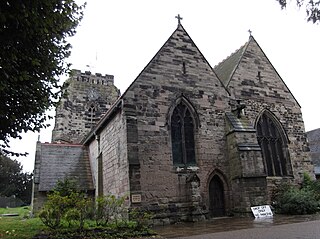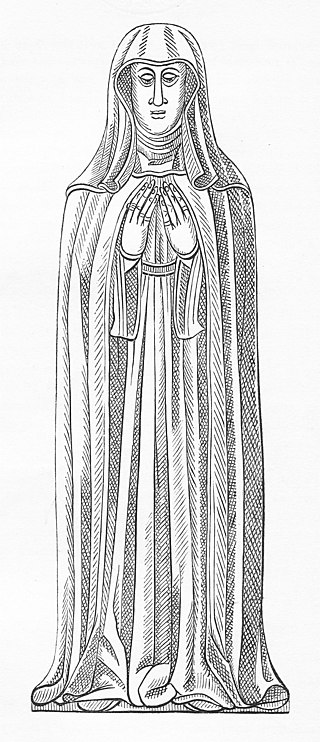
The dissolution of the monasteries, occasionally referred to as the suppression of the monasteries, was the set of administrative and legal processes between 1536 and 1541, by which Henry VIII disbanded monasteries, priories, convents, and friaries in England, Wales, and Ireland; expropriated their income; disposed of their assets; and provided for their former personnel and functions.

Syon Abbey, also called simply Syon, was a dual monastery of men and women of the Bridgettine Order, although it only ever had abbesses during its existence. It was founded in 1415 and stood, until its demolition in the 16th century, on the left (northern) bank of the River Thames within the parish of Isleworth, in the county of Middlesex, on or near the site of the present Georgian mansion of Syon House, today in the London Borough of Hounslow. It was named after the biblical holy "City of David which is Zion", built on the eponymous Mount Zion.

Wilton Abbey was a Benedictine convent in Wiltshire, England, three miles west of Salisbury, probably on the site now occupied by Wilton House. It was active from the early tenth century until 1539.

Polesworth Abbey was a Benedictine nunnery in Polesworth, North Warwickshire, England.

Godstow is a hamlet about 2.5 miles (4 km) northwest of the centre of Oxford. It lies on the banks of the River Thames between the villages of Wolvercote to the east and Wytham to the west. The ruins of Godstow Abbey, also known as Godstow Nunnery, are here. A bridge spans the Thames and the Trout Inn is at the foot of the bridge across the river from the abbey ruins. There is also a weir and Godstow lock.

Fovant is a village and civil parish in southwest Wiltshire, England, lying about 9 miles (14 km) west of Salisbury on the A30 Salisbury-Shaftesbury road, on the south side of the Nadder valley.

Dinton is a village, civil parish and former manor in Wiltshire, England, in the Nadder valley on the B3089 road about 8 miles (13 km) west of Salisbury. The parish population was 696 at the 2011 census, estimated at 733 in 2019. The civil parish includes the village of Baverstock, about 1 mile (1.6 km) east of Dinton village.

The Abbey Pax Mariae, more commonly referred to as Vadstena Abbey, situated on Lake Vättern in the Diocese of Linköping, Sweden, is a monastery of nuns within the Bridgettine Order. It was active from 1346 until 1595 and has been active since 1963, regaining status as an autonomous abbey in 1991.

Barking Abbey is a former royal monastery located in Barking, in the London Borough of Barking and Dagenham. It has been described as having been "one of the most important nunneries in the country".

Burnham Abbey was a house of Augustinian canonesses regular near Burnham in Buckinghamshire, England. It was founded in 1266 by Richard, 1st Earl of Cornwall. The abbey of St Mary consisted of around twenty nuns at the outset, but was never wealthy and by the time of its dissolution in 1539 there were only ten.
Amesbury Abbey was a Benedictine abbey of women at Amesbury in Wiltshire, England, founded by Queen Ælfthryth in about the year 979 on what may have been the site of an earlier monastery. The abbey was dissolved in 1177 by Henry II, who founded in its place a house of the Order of Fontevraud, known as Amesbury Priory.
Amesbury Priory was a Benedictine monastery at Amesbury in Wiltshire, England, belonging to the Order of Fontevraud. It was founded in 1177 to replace the earlier Amesbury Abbey, a Saxon foundation established about the year 979. The Anglo-Norman Amesbury Priory was disbanded at the Dissolution of the monasteries and ceased to exist as a monastic house in 1539.
Wherwell Abbey was an abbey of Benedictine nuns in Wherwell, Hampshire, England.
Events from the 1530s in England.
Dame Eleanor Carey was an early modern English noblewoman and nun, known for being endorsed as a candidate for abbess of Wilton Abbey by Anne Boleyn until her scandalous life was discovered.
Bodenham is a village in Herefordshire, England.

Lacock Abbey was a monastery founded at Lacock, in the county of Wiltshire in England, in the early 13th century by Ela, Countess of Salisbury, as a house of Augustinian Canonesses regular. It was seized by the crown in 1539 during the Dissolution of the Monasteries under Henry VIII. It then became a country house, Lacock Abbey, notable as the site of Henry Fox Talbot's early experiments in photography.
Elizabeth Zouche, was an English abbess. She was the last abbess of Shaftesbury Abbey, a Benedictine nunnery founded by Alfred the Great which was one of the largest and richest in England. She signed the deed of surrender on 23 March 1539 which brought the 650 year life of the abbey to an abrupt end and granted all its property and wealth to Henry VIII.

Agnes Jordan was the last pre-reformation Abbess of Syon Monastery. It was she who had to sign the deed of surrender on 25 November 1539 which brought to an abrupt end the life of the abbey and granted all its property and wealth to Henry VIII. She was the sister of Isabel Jordan, prioress and later abbess of Wilton Abbey.
Isabel Jordayne was an English abbess of Wilton Abbey. She was the penultimate abbess whose election was debated by Cardinal Wolsey and Anne Boleyn before Henry VIII, the abbey's patron, chose her.












